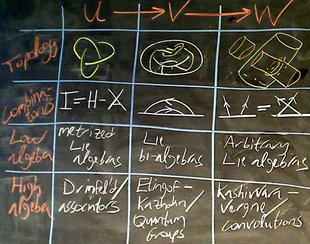AKT-09/Tricolourability: Difference between revisions
No edit summary |
(clearified my confusion with the usage of the word 'strand'; added link to demonstration of knot coloring) |
||
| Line 1: | Line 1: | ||
{{AKT-09/Navigation}} |
{{AKT-09/Navigation}} |
||
The tricolourability criterion for knot diagrams may be equivalently expressed as: is it possible to associate to each strand a member of Z/3Z such that, for each crossing, the sum of the three numbers associated to the three strands involved is 0 mod 3 (that is, the three numbers are either all distinct or all the same) while excluding the case of associating the same number to every strand? |
The tricolourability criterion for knot diagrams may be equivalently expressed as: is it possible to associate to each strand (I am not sure what is the correct terminology, but 'segment' is a more intuitive term for me as you are allowed to change color after an undercrossing; this allowance makes sense because otherwise we would end up with a single color for the whole knot; see example of how to colour a knot diagram at http://en.wikipedia.org/wiki/Tricolorability) a member of Z/3Z such that, for each crossing, the sum of the three numbers associated to the three strands involved is 0 mod 3 (that is, the three numbers are either all distinct or all the same) while excluding the case of associating the same number to every strand? |
||
This fact can be exploited to give an algorithm for determining tricolourability of a knot diagram whose complexity is polynomial in the |
This fact can be exploited to give an algorithm for determining tricolourability of a knot diagram whose complexity is polynomial in the number of crossings. (A naive test which tried all possible colourings would require 3^(number of strands) checks.) |
||
Define the variables <math>S_1 , ... , S_n</math> which are associated with the strands of a knot diagram D. Each crossing yields an equation of the form <math>S_a + S_b + S_c = 0</math>. We can also (without loss of generality) assume <math>S_1 = 0</math>. Let M be the matrix over Z/3Z encoding the aforementioned relations. The nullity of M is non-zero if and only if there is a valid tricolouring of D. |
Define the variables <math>S_1 , ... , S_n</math> which are associated with the strands of a knot diagram D. Each crossing yields an equation of the form <math>S_a + S_b + S_c = 0</math>. We can also (without loss of generality) assume <math>S_1 = 0</math>. Let M be the matrix over Z/3Z encoding the aforementioned relations. The nullity of M is non-zero if and only if there is a valid tricolouring of D. |
||
Revision as of 17:21, 18 September 2009
| ||||||||||||||||||||||||||||||||||||||||||||||||||||||
The tricolourability criterion for knot diagrams may be equivalently expressed as: is it possible to associate to each strand (I am not sure what is the correct terminology, but 'segment' is a more intuitive term for me as you are allowed to change color after an undercrossing; this allowance makes sense because otherwise we would end up with a single color for the whole knot; see example of how to colour a knot diagram at http://en.wikipedia.org/wiki/Tricolorability) a member of Z/3Z such that, for each crossing, the sum of the three numbers associated to the three strands involved is 0 mod 3 (that is, the three numbers are either all distinct or all the same) while excluding the case of associating the same number to every strand?
This fact can be exploited to give an algorithm for determining tricolourability of a knot diagram whose complexity is polynomial in the number of crossings. (A naive test which tried all possible colourings would require 3^(number of strands) checks.)
Define the variables which are associated with the strands of a knot diagram D. Each crossing yields an equation of the form . We can also (without loss of generality) assume . Let M be the matrix over Z/3Z encoding the aforementioned relations. The nullity of M is non-zero if and only if there is a valid tricolouring of D.












